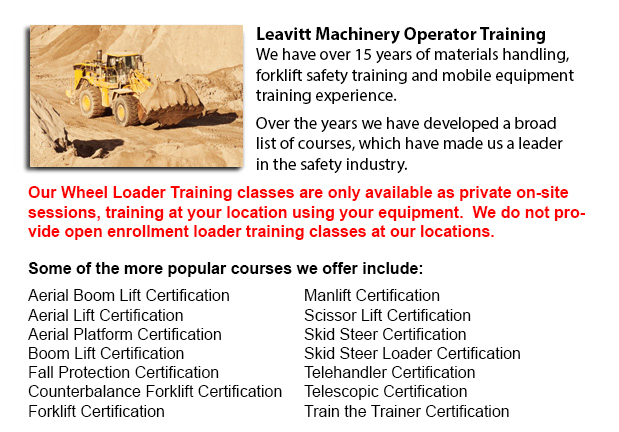
Kingston Wheel Loader Operator Training - Cranes are industrial machines which use levers or pulleys so as to pick up significant loads. The Romans utilized cranes to raise huge monuments, which means these machines have been around for at least 2,000 years. Numerous Medieval churches used cranes in their creation and the Egyptian people might have utilized them when building the pyramids.
The modern type of a crane could be either complex or simple, and cranes vary based on their function. Mobile cranes, for example are rather simple. A telescopic boom or steel truss mounts its movable platform. A system of pulleys or levers lifts the boom and there is often a hook suspended. These cranes are often used for earthmoving or demolition by changing the hook out with another piece of gadget like a wrecking ball or a bucket. Telescopic cranes have a series of hydraulic tubes which fit together to form the boom. These units could also be mobile.
Conventional wheels, or particular wheels intended for a railroad track or caterpillar track enable these mobile booms to be able to navigate uneven and unpaved surfaces.
Rough terrain and truck mounted cranes are even mobile with outriggers placed on the truck mounted unit enhance stability. Nonetheless, rough terrain cranes consist of a base which tends to resemble the bottom of a 4-wheel drive. These cranes are outfitted to be able to work on rough surface making them perfect in the construction industry for instance.
Usually used on railroads and in ports, the Gantry crane can move and unload huge containers off ships and trains. Their bases consist of massive crossbeams that run on rails so as to lift containers from a location to another. A portainer is a special type of gantry which moves supplies onto and off of ships in particular.
Floating cranes are connected on pontoons or barges and are another essential piece of equipment essential to the shipping industry. As they are places in water, they are used for a variety of services including port construction, building bridges and salvaging ships. Floating cranes are capable of handling very heavy cargo and containers and like portainers, they can also unload ships.
Loader cranes consist of hydraulic driven booms that are fitted onto trailers to load supplies onto a trailer. The jointed sections of the boom could be folded down if the equipment is not in being utilized. This particular type of crane could be likewise considered telescopic since one part of the boom can telescope for more versatility.
Often used in automated warehouses, stacker cranes tend to follow an automated retrieval system and could work by remote. These cranes are outfitted along with a forklift equipment and could be seen in big automated freezers, obtaining or stacking food. Utilizing this kind of system enables workers to remain out of that freezing situation.
Tower cranes are often the tallest cranes and normally do not have a movable base. They have to be assembled piece by piece. Their base resembles a long ladder with the boom perpendicular to the base. These cranes specialize in the construction of tall buildings and are normally affixed to the inside of the building itself through the construction period.
-
Narrow Aisle Forklift / Order Picker Training / Electric Pallet Jack / Electric Pallet Truck Training in Kingston
A pallet lift is a piece of equipment dedicated in the moving of pallets of various dimensions and weights. They might be utilized as an accessory for forklifts, cranes and other styles of heavy machinery or be applied on their own. Pallet lifts are... More -
Kingston Forklift Training School
Kingston Forklift Training School - Forklift Training School - Industry and federal regulators have established the criteria for forklift safety training based on their existing regulations and standards. People wishing to operate a forklift must fin... More -
Kingston Scissor Lift Certification
Kingston Scissor Lift Certification - Scissor lift platforms are utilized at work locations to enable tradespeople - such as iron workers, welders and masons - to reach their work. Making use of a scissor lift platform is usually secondary to their t... More -
Kingston Boom Lift Safety Training
Kingston Boom Lift Safey Training - Boom lifts are a type of elevated work platform or aerial lifting device that are normally utilized in warehousing, construction and industry. Boom lifts could be made use of in practically whichever environment du... More -
Kingston Fall Protection Ticket
Kingston Fall Protection Ticket - Fall-related incidents are the number one reason of death in the construction business. The possibility for fall accidents very much increases based upon the type of work which is being accomplished within your workp... More -
Telehandler Training in Kingston
Telescopic handlers normally called telehandlers for short, are an extremely popular piece of heavy construction machinery. They are widely utilized in the construction and agricultural trades. These machines have farthest reaching ability and are ab... More -
Kingston Warehouse Forklift Training Programs
Kingston Warehouse Forklift Training Programs - Warehouses could either be retail, industrial or commercial facilities, functioning from bulk product retailing to product distribution services. Regardless of the type of warehouse, personnel inside wa... More -
Kingston Heavy Equipment Ticket
Kingston Heavy Equipment Ticket - Depending on the nature of the job at hand, the kind of construction machinery that a heavy equipment operator utilizes varies. Every type of equipment is built to do particular jobs in the most effective method comm... More

Forklift Certification Kingston
TOLL FREE: 1-888-254-6157
Kingston, Ontario
forkliftcertificationkingston.com
Email Us
About Us


